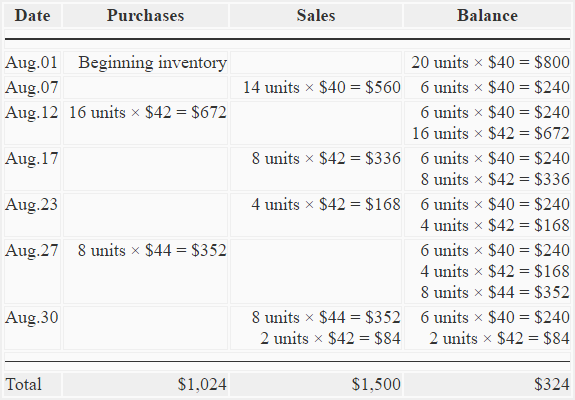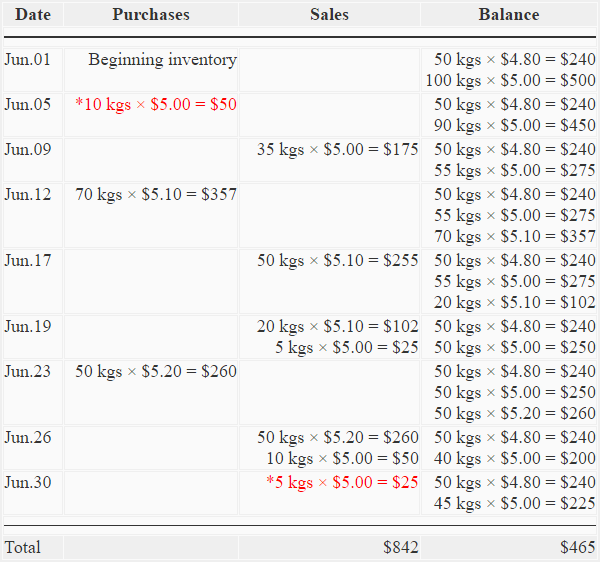A Perpetual Inventory System Quizlet
In contrast to first-in, showtime-out (FIFO) method, the last-in, first-out (LIFO) method of inventory valuation assumes that the concluding costs incurred to buy merchandise or direct materials are commencement costs charged against revenues. In other words, it assumes that the toll of trade sold (in a merchandising company) or the toll of materials issued to product section (in a manufacturing company) is the cost of near recent purchases.
Like starting time-in, first-out (FIFO), last-in, starting time-out (LIFO) method can exist used in both perpetual inventory system and periodic inventory arrangement. The post-obit example explains the use of LIFO method for computing cost of goods sold and the toll of ending inventory in a perpetual inventory system.
Example – LIFO perpetual inventory arrangement in a merchandising company:
BZU uses perpetual inventory organisation to record purchases and sales and LIFO method to valuate its inventories. The company has provided the following data most commodity DX-13C and wants your assist in computing the cost of commodity DX-13C sold and the cost of catastrophe inventory of commodity DX-13C.
- Aug. 01: Showtime inventory; xx units @ $40 per unit.
- Aug. 07: Sales; 14 units.
- Aug. 12: Purchases; 16 units @ $42 per unit.
- Aug. 17: Sales; viii units.
- Aug. 23: Sales; 4 units.
- Aug. 27: Purchases; 8 units @ $44 per unit.
- Aug. 30: Sales; 10 units.
Required:
- Prepare a LIFO perpetual inventory card.
- Compute cost of goods sold and the price of ending inventory using LIFO method.
Solution:
(1). LIFO perpetual inventory card:

(2). Cost of appurtenances sold (COGS) and ending inventory:
LIFO perpetual inventory carte (prepared above) can assistance compute cost of goods sold and ending inventory.
a. Cost of goods sold (COGS): $560 + $336 + $168 + $436 = $ane,500
b. Catastrophe inventory: [$240 + $84] = $324
When LIFO method is used in a perpetual inventory system, it is typically known as "LIFO perpetual system".
The higher up example explains the use of LIFO perpetual system in a merchandising company. In manufacturing companies, it is used to compute the toll of materials issued to production and cost of ending inventory of raw materials (as well known every bit straight materials). Consider the following example:
Case – LIFO perpetual organization in a manufacturing company:
The 3 Star company manufactures product X. Material K5 is used to manufacture product X. The information near the acquisition and issuance of fabric K5 for the calendar month of June is given beneath:
- Jun. 01: Get-go inventory; 50 kgs @ $4.80/kg and 100 kg @ $five.00/kg.
- Jun. 05: 10 kgs of material K5 were returned to supplier.
- Jun. 09: 35 kgs of fabric K5 were issued to factory.
- Jun. 12: seventy kgs of material K5 were purchased @ $five.10/kg.
- Jun. 17: 50 kgs of textile K5 were issued to manufacturing plant.
- Jun. 19: 25 kgs of material K5 were issued to manufacturing plant.
- Jun. 23: 50 kgs of material K5 were purchased @ $five.20/kg
- Jun. 26: lx kgs of fabric K5 were issued to factory.
- Jun. 30: 5 kgs of material K5 were returned from factory to shop room.
A perpetual inventory system is used to account for acquisition and issuance of directly materials.
Required: Compute the toll of material K5 issued to mill and the price of material K5 at the end of June using last-in, kickoff-out (LIFO) method.
Solution:
As the company uses perpetual inventory organization, a materials ledger card would be prepared to compute the price of materials issued to manufacturing plant and the cost of materials on hand at the end of the month. Materials ledger card is similar to inventory menu prepared higher up. Materials ledger card of Three Star company is give below:
(i). LIFO perpetual material card:

* Materials returned from store room to supplier is usually recorded in purchases column and materials returned from mill to store room is ordinarily written in issues column. The returns are commonly written in red ink to differentiate them from normal purchases and issues.
(2). Cost of cloth issued to manufactory:
= $175 + $255 + $102 + $25 + $260 + $50 – $25*
= $842
*Material returned from manufacturing plant to store room
(3). Cost of inventory on hand on June 30th:
= $240 + $225
= $465
More from Inventory costing methods (explanations):
A Perpetual Inventory System Quizlet,
Source: https://www.accountingformanagement.org/last-in-first-out-lifo-method-in-a-perpetual-inventory-system/
Posted by: hamelwithris.blogspot.com


0 Response to "A Perpetual Inventory System Quizlet"
Post a Comment